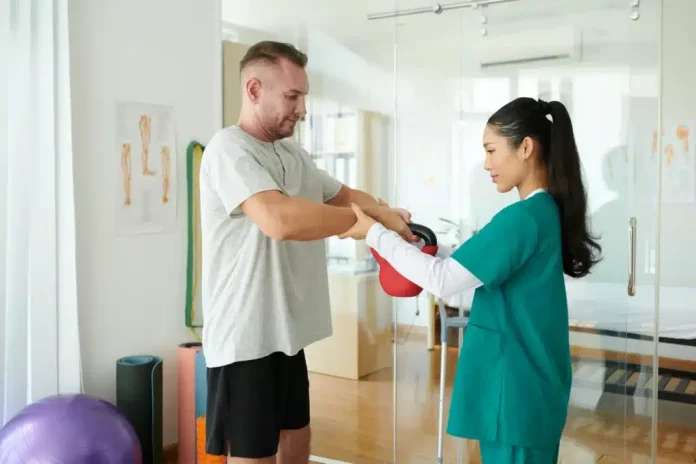Spinal fusion can offer much-needed relief and stability for patients with chronic back conditions, but recovery can come with its own set of challenges. Dr. Larry Davidson, a specialist in spine health, believes that targeted physical therapy exercises are critical to reducing pain and restoring function after spinal fusion surgery. These exercises go beyond general rehabilitation; they’re designed to support healing, improve biomechanics and prevent long-term discomfort.
When tailored properly, physical therapy can help manage pain without overloading the surgical site, accelerating recovery while minimizing complications. It promotes circulation, reduces stiffness and helps patients regain mobility with greater confidence. By progressing exercises gradually and monitoring response closely, therapists can adapt the program to suit each patient’s healing timeline and tolerance level.
The Connection Between Movement and Pain Relief
Although rest is necessary immediately following spinal fusion, too much inactivity can lead to stiffness, muscle imbalances and pain. As healing progresses, specific exercises become essential for reactivating, stabilizing muscles, improving posture and enhancing circulation, all of which reduce pain naturally.
Movement also supports the body’s healing processes by increasing blood flow delivering oxygen and nutrients to recovering tissues. It helps reduce inflammation and contributes to more efficient wound and bone healing. Importantly, consistent movement prevents the fear of motion that can develop after surgery, which sometimes leads to guarding, compensation and further pain.
Starting With the Basics: Core Activation and Breathing
In the first stage of therapy, typically beginning within days or weeks after surgery (as approved by the surgeon), the focus is on gentle core activation. Exercises such as abdominal bracing and diaphragmatic breathing help patients engage their deep core muscles without straining the spine.
Breathing exercises are not only beneficial for oxygenation but also for pain regulation. Deep breathing activates the parasympathetic nervous system, promoting relaxation and reducing perceived pain levels. When paired with light isometric holds, such as engaging the transverse abdominis or pelvic floor, patients can begin building foundational strength while protecting the fused area.
Dr. Larry Davidson remarks, “Spinal fusion procedures regularly involve the implantation of certain types of implants. A merger of AI and 3D printing could result in the production of an implant that uniquely serves the needs of a specific patient. Such preparation would be done before a planned procedure based on the imaging studies of the patient’s spine.” This level of personalized surgical planning lays the groundwork for safer rehabilitation, allowing early-stage therapy to align closely with each patient’s anatomical and healing profile.
Mobilizing the Hips and Lower Body for Spinal Support
Post-fusion pain often results from tension or stiffness in the hips and lower body. When the lumbar spine is fused, for example, the hips must compensate for lost spinal flexibility. Stretching and mobilization exercises for the hip flexors, hamstrings and glutes help prevent this compensation from turning into chronic pain.
Simple stretches, such as supine hamstring stretches, gentle knee-to-chest movements and seated piriformis stretches, can relieve pressure on the lower back while improving pelvic alignment. Over time, these exercises reduce muscular tightness, which often contributes to lingering postoperative pain.
Strengthening the glutes through controlled bridges or clamshells (as tolerated) also helps stabilize the pelvis and reduce stress on the spine.
Improving Posture Through Mid-Back and Shoulder Work
Another target area in post-fusion rehabilitation is the thoracic spine and shoulder girdle. Poor posture can place excessive pressure on the fused segments, exacerbating pain. Strengthening the muscles that support upright posture, including the rhomboids, middle trapezius and scapular stabilizers, helps align the spine and reduces compensatory strain.
Therapists often prescribe wall angels, scapular retractions and band pull-apart to engage these muscles safely. Paired with postural cues such as “chin tuck” or “shoulder blades down and back,” these movements gradually retrain the body to hold itself in a more neutral, pain-free position.
These posture-focused exercises also improve breathing capacity, reduce neck tension and enhance balance, all of which support overall recovery.
Controlled Weight-Bearing and Balance Progression
As the patient becomes more comfortable and pain decreases, physical therapists introduce standing exercises to improve balance and weight-bearing control. Exercises such as heel-to-toe walking, single-leg stands and mini-squats help restore confidence in movement and prepare patients for daily activities.
These movements also help address proprioception, the body’s awareness of its position in space, which can be impaired following surgery or due to chronic preoperative pain. Improved proprioception enhances coordination and reduces the risk of falls, making it safer for patients to resume their normal routines.
Balance exercises are always introduced gradually, with support and supervision, until the patient demonstrates stability and strength.
Managing Pain with Movement, Not Avoidance
Pain management after spinal fusion doesn’t mean avoiding discomfort altogether; it means learning how to move through mild discomfort safely without triggering more serious setbacks. Physical therapists play a critical role in educating patients about “hurt versus harm,” helping them distinguish between normal post-surgical sensations and problematic symptoms.
Through consistent, progressive movement, patients often find that their baseline pain decreases over time. The fear of motion diminishes, muscles strengthen, and the nervous system begins to recalibrate its pain signals. Active engagement in physical therapy becomes a positive feedback loop. Movement reduces pain, and reduced pain encourages more movement.
Using Tools to Aid Exercise and Recovery
Therapists may incorporate tools to enhance recovery in addition to bodyweight exercises. Resistance bands are commonly used to add light, controlled resistance without placing excess load on the spine. Foam rollers, when appropriate, can release tension in the muscles surrounding the spine or hips.
Therapeutic balls and stability cushions may be introduced for core training or balance improvement, while braces or lumbar supports may be worn temporarily during early-stage exercises to increase comfort and confidence.
Technology such as wearable movement sensors or pain-tracking apps may also help monitor progress and personalize the therapy plan further.
Adapting to Long-Term Needs
After the acute recovery phase, physical therapy goals shift toward long-term maintenance and injury prevention. Patients are often transitioned to home exercise programs that include spinal mobility drills, strength training for the posterior chain and cardiovascular conditioning.
Low-impact aerobics activities such as walking, swimming and cycling help maintain endurance and improve blood flow without placing excess stress on the spine. Patients are encouraged to remain active while respecting their fusion site and listening to their body’s cues.
Regular reassessments and occasional booster sessions with a therapist can help ensure that progress continues and that any flare-ups are addressed early.









